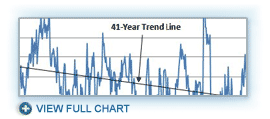The latest employment report from the U.S
 . Department of Labor shows further degradation of the employment picture. Here's the short list of bad news items:
. Department of Labor shows further degradation of the employment picture. Here's the short list of bad news items:* The civilian labor force declined by a whopping 571,000 to September from August.
* Employment declined even more, by 785,000.
* Unemployment increased by 214,000.
* Total nonfarm payroll jobs lost increased by 62,000 to 263,000.
* The number of people of employment age not in the labor force increased by 807,000.
* The official unemployment rate, or U-3, increased to 9.8% from 9.7%.
* The average private work week declined to tie a record low of 33 hours in September, equaling June.
Are there any exceptions to the bad news? Here are a couple of positives:
* Average weekly earnings were essentially unchanged to September from August and up slightly (up 0.5%) from the average for May, June and July.
* Total nonfarm payrolls declined by only 37,000 from the July level and 60,000 from the average for May, June and July -- a second derivative improvement.
Shrinking Labor Force
Just two weeks ago, I reviewed the shrinking labor force in an article for TheStreet.com. The size of the problem has doubled the recent previous decline, with a September loss in the civilian labor force of more than half a million. This is an historic decline, reflected in the following graph, with more than 1 million people disappearing from the labor force in just four months.
Civilian Labor Force Change (Y-over-Y)

Source: U.S. Dept. of Labor
Alternative Measurements of Unemployment
I proposed that employment and unemployment should be measured against full-time employment being a 40-hour work week. Thus, if someone is working 32 hours a week, he should be counted as 80% employed; a 20-hour week would constitute 50% employment. An exception in this methodology is that anyone working part-time by choice will be counted as one employed person. The Labor Department counts all of these as one employed person, which overstates the size of the employment market.
The Labor Department reports several measurements of unemployment, the most common being the U-3 metric. Many also look at the so-called "underemployment" number, or U-6, which attempts to include some of the discouraged without work who aren't currently counted in the labor force, as well as some effects of part-time employment. The unemployment number I proposed corresponding to U-3 has been labeled U-7, and corresponding to U-6 has been called U-9. These numbers are summarized in the following table.
The serious degradation in employment is emphasized by the more rapid unemployment increases in the measurements based on a 40-hour week (U-7 and U-9) compared with Labor's "body count" measurements (U-3 and U-6).
Alarming News
Stock and bond market action following the announcement of the monthly employment data indicated a rather sanguine reaction from investors. Stocks closed fractionally lower, while bonds sold off marginally. These historically large negative developments in the labor market are apparently just not that big a deal for investors.
For my part, this is alarming news and strengthens my conviction that the rally from March 9 is over. Only a reversal of the contractions in the number of people employed and those that are available for work -- the labor force -- can provide a basis for economic improvement. These things are needed for an increase in consumption, a bottom in the housing market and to avoid further corporate cost-cutting. Reducing costs is primarily management-speak for cutting employment. This is a self-reinforcing spiral that must be broken.
This post has been republished from The Street, an investment news and analysis site.
No comments:
Post a Comment